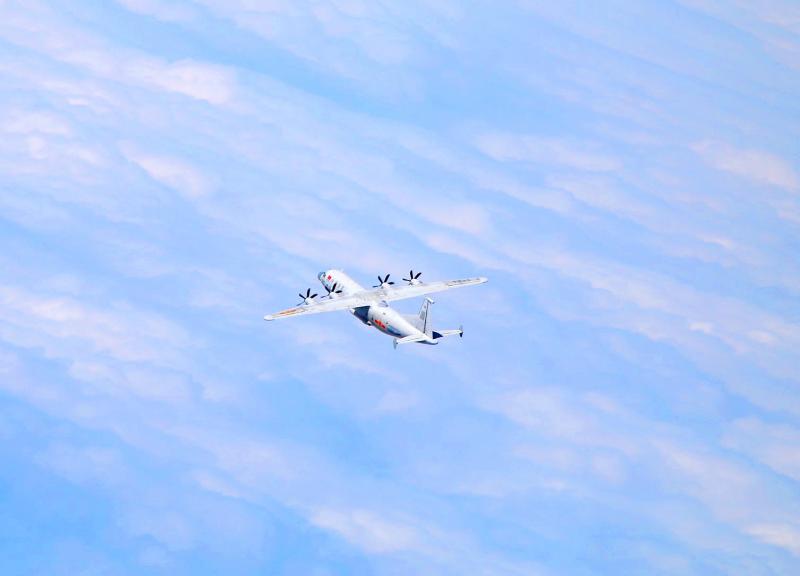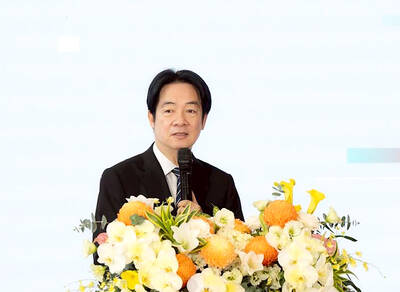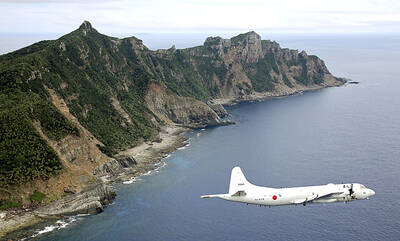Taiwan is bracing for more Chinese military patrols next year, after incursions by the Chinese People’s Liberation Army (PLA) more than doubled this year, fueling concern about a clash between the region’s big powers.
Since January, Chinese warplanes have made about 950 forays into Taiwan’s air defense identification zone (ADIZ), Ministry of National Defense data showed, up from about 380 sorties last year, when the ministry began releasing the data amid a sharp rise in such flights.
Tensions could rise further in the coming year, with key events on the political calendars for Taipei and Beijing. President Tsai Ing-wen (蔡英文) is facing local elections viewed as a bellwether for the next presidential race, while Chinese President Xi Jinping (習近平) is heading toward a party congress in which he is expected to secure a precedent-busting third term in power.

Photo courtesy of the Ministry of National Defense
“China will send more military airplanes into Taiwan’s ADIZ next year with more intimidating operations,” said Kuo Yu-jen (郭育仁), director of the Institute for National Policy Research. “The situation in 2022 is worth being concerned about as it’s going to be a turning point.”
The political events increase pressure on Tsai and Xi to show strength and the resolve to respond to perceived provocations.
US President Joe Biden, who has affirmed the US’ commitment to defend Taiwan from any Chinese attack, also has a political incentive to maintain a firm line toward Beijing before congressional mid-term elections.
Minister of National Defense Chiu Kuo-cheng (邱國正) told lawmakers in October that the closer Chinese planes came to Taiwan, “the stronger we will hit back.”
“China’s quasi-military means are part of its gray-zone tactic to intimidate and coerce Taiwan — it’s a hybrid threat,” said Ou Si-fu (歐錫富), a research fellow at the Institute for National Defense and Security Research, citing other efforts including luring Taiwan’s diplomatic allies away and economic coercion.
“China’s activities in the Strait will increase as its competition with the US intensifies,” Ou added.
The military can handle next year’s expected increase in PLA incursions, Chiu told reporters yesterday during a break in a meeting of the legislature’s Foreign Affairs and National Defense Committee in Taipei.
The armed forces maintain the combat readiness of personnel and equipment at all times with the expectation that the enemy is capable and strong, Chiu said.
On Tuesday, Biden signed the fiscal 2022 US National Defense Authorization Act, which includes provisions recommending that Taiwan be included in next year’s Rim of the Pacific Exercise.
Asked to comment on the act, Chiu said that Taiwan welcomes any aid from foreign governments, but the country’s existing capabilities must be considered before defense cooperation is strengthened.
Additional reporting by Jonathan Chin

MISINFORMATION: The generated content tends to adopt China’s official stance, such as ‘Taiwan is currently governed by the Chinese central government,’ the NSB said Five China-developed artificial intelligence (AI) language models exhibit cybersecurity risks and content biases, an inspection conducted by the National Security Bureau (NSB) showed. The five AI tools are: DeepSeek, Doubao (豆包), Yiyan (文心一言), Tongyi (通義千問) and Yuanbao (騰訊元寶), the bureau said, advising people to remain vigilant to protect personal data privacy and corporate business secrets. The NSB said it, in accordance with the National Intelligence Services Act (國家情報工作法), has reviewed international cybersecurity reports and intelligence, and coordinated with the Ministry of Justice Investigation Bureau and the National Police Agency’s Criminal Investigation Bureau to conduct an inspection of China-made AI language

LIMITS: While China increases military pressure on Taiwan and expands its use of cognitive warfare, it is unwilling to target tech supply chains, the report said US and Taiwan military officials have warned that the Chinese People’s Liberation Army (PLA) could implement a blockade within “a matter of hours” and need only “minimal conversion time” prior to an attack on Taiwan, a report released on Tuesday by the US Senate’s China Economic and Security Review Commission said. “While there is no indication that China is planning an imminent attack, the United States and its allies and partners can no longer assume that a Taiwan contingency is a distant possibility for which they would have ample time to prepare,” it said. The commission made the comments in its annual

‘TROUBLEMAKER’: Most countries believe that it is China — rather than Taiwan — that is undermining regional peace and stability with its coercive tactics, the president said China should restrain itself and refrain from being a troublemaker that sabotages peace and stability in the Indo-Pacific region, President William Lai (賴清德) said yesterday. Lai made the remarks after China Coast Guard vessels sailed into disputed waters off the Senkaku Islands — known as the Diaoyutai Islands (釣魚台) in Taiwan — following a remark Japanese Prime Minister Sanae Takaichi made regarding Taiwan. Takaichi during a parliamentary session on Nov. 7 said that a “Taiwan contingency” involving a Chinese naval blockade could qualify as a “survival-threatening situation” for Japan, and trigger Tokyo’s deployment of its military for defense. Asked about the escalating tensions

DISPUTE: A Chinese official prompted a formal protest from Tokyo by saying that ‘the dirty head that sticks itself out must be cut off,’ after Takaichi’s Taiwan remarks Four armed China Coast Guard vessels yesterday morning sailed through disputed waters controlled by Japan, amid a diplomatic spat following Japanese Prime Minister Sanae Takaichi’s comments on Taiwan. The four ships sailed around the Senkaku Islands — known as the Diaoyutai Islands (釣魚台) to Taiwan, and which Taiwan and China also claim — on Saturday before entering Japanese waters yesterday and left, the Japan Coast Guard said. The China Coast Guard said in a statement that it carried out a “rights enforcement patrol” through the waters and that it was a lawful operation. As of the end of last month,